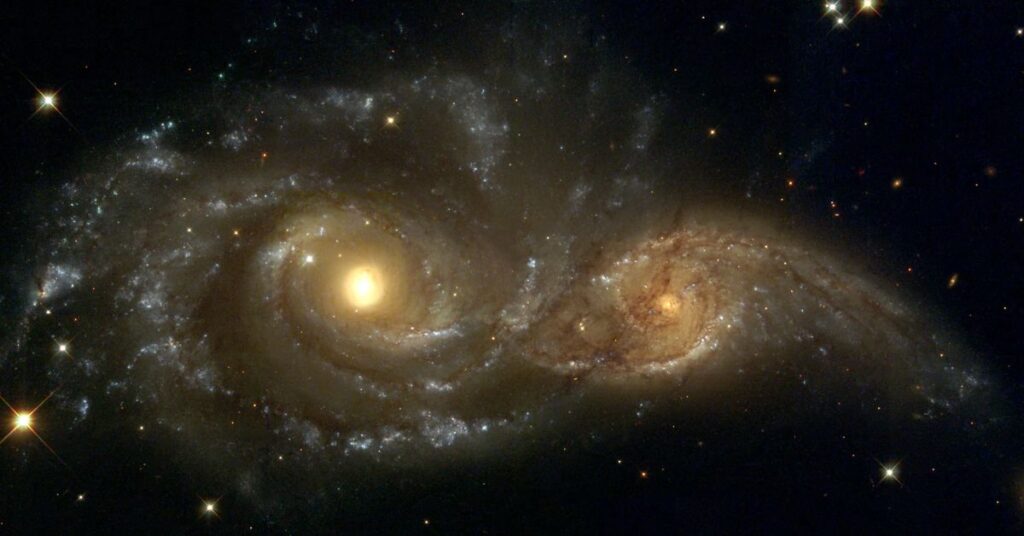
By virtue of a historical cosmic event, the discovery of gravitational waves, is just an another revelation that humans are custodian in the universe
On 12th Feb, a colossal announcement was made that first time in human history, gravitational waves were detected. The news overwhelmingly received by the scientific community across the globe. “This is transformational” said Prof Alberto Vecchio, of the University of Birmingham, “We have observed the universe through light so far. But we can only see part of what happens in the universe. Gravitational waves carry completely different information about phenomena in the universe. So we have opened a new way of listening to a broadcasting channel which will allow us to discover phenomena we have never seen before,” he said.
The Columbia University Prof Szabolcs Marka said “I think this will be one of the major breakthroughs in physics for a long time. Everything else in astronomy is like the eye. Finally, astronomy grew ears. We never had ears before”.
What’s the event all about?
You may be wondering what’s happening, what are gravitational ways? What’s so special about there detection? What made it possible? Let me explain. The expanse of universe is immeasurable; it contains incredibly giant planets and stars. When a star ends its life cycle it dies and collapses giving rise to a spot in the space-time known as Black Hole in which the matter squeezed and get packed so densely that results in a strongest gravity pull, so strong even light cannot get out. Since without the light emission the object appears black, hence it is a Black Hole ( ثقب اسود), an invisible one. With the help of special tools scientists identify a black hole as its strong gravity affects the stars and gas around.
Black holes vary in sizes, from tiny like an atom to an incredibly giant one. Even a black hole of the size of an atom is far bigger than few suns as the highly squeezed stuff make it a dense and compact one. Another type of black hole is called stellar whose mass can be up to twenty times more than the mass of the sun. Even bigger than stellar are known as supermassive. These black holes have masses that amount to more than the masses of one million suns together.
The Gravitational Waves

The Gravitational waves (ثقلی موجیں) are ripples in the curvature of spacetime which travels as waves moving away from the source. It was predicted by Albert Einstein in 1916 on the basis of his theory of general relativity. The theory suggest, the pair of black holes orbiting around each other lost energy due to emission of gravitational waves. Due to lost energy, they were gravitationally drawn closer to each other by virtue of which the spinning became faster and they emit even more gravitational waves and lost even more energy. The loss of energy amounts to three solar masses. The two black holes were 36 times and 29 times the mass of the Sun; the fused black hole weighed only 62 solar masses and not 65 solar masses. The three solar masses that went missing were what created the gravitational waves. Gravitational waves are the ripples in the curvature of spacetime that propagates as waves, travelling outward from the source. The Gravitational waves emit energy as gravitational radiation.
Detection of Gravitational Waves – first of its kind in human history
It was a known fact that the gravitational waves exist but there were no scientific discoveries to ascertain the fact. For the first time in history these waves were detected. The credit goes to an enormously powerful cosmic event, two giant black holes collided and merged into one resulted in the emission of ripples in the curvature of space-time known as the Gravitational Waves which were detected by LIGO on September 14, 2015 and announced on 12th Feb, 2016 after ascertaining the collected data.
The scientists listened for 20 thousandths of a second as the two massive black holes, one 35 times the mass of the Sun, other a bit smaller one about 29 times, collided and merged. The cosmic event was so huge that the total power output of gravitational waves during the brief collision was 50 times greater than the power of all the stars in the universe, unbelievable isn’t? This huge blast of gravitational wave energy was recorded as a high-frequency data that articulated into a “chirp” sound by a pair of L-shaped antennas located around 3000 kms apart in Washington State and Louisiana known as LIGO (Laser Interferometer Gravitational-Wave Observatory). The collision and merger of the two giant black holes took place deep down the space, at a very far and unimaginable distance of about 1.3 billion light years (light year is the distance travelled by light for a one year which equals to 1,86,000 miles). The gravitational waves were on their way to earth for 1.3 billion years that discovered in September and announced in Feb after checking and rechecking the collected data.
Contributors
LIGO spokesperson Gabriela González said. “There have been hundreds of people developing the technology, doing the analysis. We are very proud of this work taking a village, a worldwide village,” González added, referring to the more than 1,000 researchers who work on the project. These researchers were from 133 scientific institutions from Germany, Australia, and Japan apart from USA. Sixty Indian scientists from across nine Indian institutes were involved in the experiment that led to this exceptional discovery.
The Applications of Gravitational Waves
The discovery of gravitational waves has signaled a new era and opened a new chapter of Gravitational Astronomy. Right now, we can only see celestial objects that emit electromagnetic radiation, visible light, x-rays, gamma rays. But objects like colliding black holes don’t emit any electromagnetic radiation; rather emit gravity, hence invisible and absolutely out of the purview of detection, but with this discovery, invisible objects in the universe may soon be visible.
The discovery is profound in many ways. Detection of gravitational waves will be possible. Violent merger of two black holes would be observed, and a strongest direct evidence of the existence of black holes.
The understanding of such a complex scientific phenomenon is not that easy and this is definitely going to be the case of gravitational waves. To know its beneficial aspect you need to understand that every discovery and invention at its preliminary stage have caused people to raise their eyebrows considering it as complex and superficial one, but later realized the actuality, just go through these instances:
- When X-rays were discovered by Wilhelm Roentgen in 1895 during his experiments on cathode ray tubes, only a few were aware of its benefits, but only a few years these high-energy electromagnetic waves became a key component in everyday medicine from diagnosis to treatment.
- The first experimental production of radio waves in 1887 by Heinrich Hertz confirmed predictions of famous electromagnetic equations. Only years later, in early 1890′s a series of demonstrations by Guglielmo Marconi proved that they had a practical use, which is evident today with the advancement of telecommunications and incredibly accessible media for social networking.
The Future
Astronomers have already utilized visible light, the infrared and ultraviolet, radio waves, x-rays and even gamma-rays in order to understand the mechanics of stars, evolution of the galaxies and expansion of the universe, starting from big bang some 13.8 billion years ago. And now that gravitational waves can be observed, scientists can theoretically use them to search for other objects that don’t emit light. According to Business Insider, LIGO’s sensitivity will increase by 1,000 times over the next four years, considerably increasing the chances of observing more gravitational waves. These recordings could contain crucial information about the origins of the universe. And there is fair chance that the discovery will support the concept of Multi-Universes (multiverse or meta-universe) (متعدد کا ئناتیں).
Where do we stand?
Soon after the announcement of a historical discovery, it is learnt that “the Islamic Science Council, Jeddah has been on high alert to trace any Quranic phrase that could be interpreted as ‘gravitational wave.’ Later it was revealed that “the Islamic scientist are having a tough time finding the evidence that they need to prove that gravitational waves existence and impact on space time was first mentioned and elaborated in the Islamic scriptures” .Till now, nothing has been explained about the phenomenon which has been termed as a new window on the universe.
But, in my view, initiatives of this kind are but a futile exercise that in no way convince the scientifically advanced nations and communities. To interpret any scientific discovery, an in depth knowledge of the phenomenon involved coupled with a profound Islamic knowledge is essential. Here, in case of collision and merger of two galactic black holes, unfathomable knowledge about the astrophysical objects is inevitable, but that we seriously lack today. Unarguably, there is not at all dearth of Islamic scholars, but a scholar blend with scientific knowledge and research is too hard to get. Thus, it makes such efforts shallow in terms of providing concrete Islamic interpretations to the discoveries and inventions.
The Glittering Past
A hope is that we have a glittering past adorn with outstanding discoveries and inventions. Our righteous elders (سلف الصالحین) have done exceptionally well in the field of different sciences and have contributed with loads of new concepts and theories, astronomy, astrology (علم النجوم), cosmology (علم التخلیقات), motion, velocity, time, gravitation, density, atmosphere, capillary attraction, space, rotation, orbital velocity etc, were the branches/terms which were extensively used and elaborated. Just look at the following scientists and their contributions:
- Jabir Ibn Hayyan (722-804), also known as Geber, the father of chemistry known for his highly influential works on alchemy and metallurgy.
- Muhammad Ibn Musa Al-Khwarizmi (780-850), also known as Algoritmi or Algaurizin, his works introduced Hindu-Arabic numerals and the concepts of algebra into European mathematics. He invented the Quadrant, the mural instrument, the sine quadrant which was used for solving trigonometric problems and making astronomical observations. He also invented Alidade.
- Ibn Ishaq Al-Kindi (801-873), also known as Alkindus, Arab philosopher and scientist, who is known as the first of the Muslim peripatetic philosopher.
- Thabit Ibn Qura (826-901), also known as Thebit, Arab mathematician, physician and astronomer; who was the first reformer of the Ptolemaic system and the founder of statics.
- Al-Battani (858-929), also known as Albatenius, Arab mathematician, scientists and astronomer who improved existing values for the length of the year and the seasons. The first reference to an “observation tube” is found in the work of Al-Battani, and the first exact description of the observation tube was given by Al-Beruni. Though these early observations tubes did not have lenses, they “enabled an observer to focus on a part of the sky by eliminating light interference”. These observation tubes were later adopted in Latin-speaking Europe, where they may have influenced the development of the telescope.
- Abu Bakr Al-Razi (865-925), also known as Rhazes, Persian alchemist and philosopher, who was one of the greatest physicians in history.
- Abu Nasr Al-Farabi (872-950), also known as Alpharabius. Arab scientist and philosopher, considered as one of the prominent thinker of medieval period.
- Al-Sijzi (945-1020), an Arab astronomer, he invented the Zuraqi; a unique astrolabe designed for a heliocentric planetary model and predicted that the earth is moving but not the sky.
- Abd Al-Rahman Al-Sufi (964), an Arab astronomer, he wrote the book of fixed stars, a star catalogue thoroughly illustrated with observations and descriptions of the stars, their positions , their apparent magnitudes and their color. He identified the Large Magellanic Cloud, which is visible from Yemen. It was not seen by Europeans until Magellan’s voyage in the sixteenth century. He also made earliest recorded observation of the Andromeda Galaxy in 964 AD, describing it as a small cloud.
- Ibn Al-Haitham (965-1040), also known as Alhazen, Arab astronomer and mathematician known for his important contributions to the principles of optics and the use of scientific experiments. He proved that light travels in straight lines, also gave the first clear description and correct analysis of the camera obscura and pinhole camera and built the world’s first camera obscura.
- Abu Al-Raihan Al-Beruni (973-1048), an Arab scientist. He proved that light has a finite speed and he was the first to theorize that the speed of light is much faster than the speed of sound. He also hypothesized that India was once covered by the Indian Ocean while observing rock formations at the mouths of rivers, introduced techniques to measure the earth and distances on it using triangulation, and measured the radius of the earth as 6339.6 km, the most accurate up until the sixteenth century.
- Ibn Sina (980-1037), also known as Avicenna, a Persian philosopher and scientist known for his contributions to Aristotelian philosophy and medicine.
- Omar Khayyam (1048-1131), Persian mathematician, astronomer and poet, known for his scientific achievements and Rubaiyat (quatrains).
- Ibn Rushd (1126-1198), also known as Averroes, Arab philosopher and scholar who produced a series of summaries and commentaries on most of Aristotle’s works on Plato’s Republic.
- Ibn Al-Baitar (1197-1248), Arab scientist, botanist and physician who systematically recorded the discoveries made by Islamic physicians in the middle ages.
- Nasir Ad-Din Al-Tusi (1201-1274), an astronomer. The Maragheh Observatory was founded by him; it was the first example of the observatory as a research institute.
- Ibn Battuta (1304-1369), also known as Shams Ad-Din, Arab traveler and scholar who wrote one of the most famous travel books in history, Rihlah.
- Taqi Ad-Din Ibn Mar’uf Al-Asadi (1529-1585), he built the Istanbul observatory of Taqi Ad-Din, the largest astronomical observatory in its time. He produced astronomical catalogues more accurate than those of Tycho Brahe and Nicholas Copernicus. Taqi Ad-Din was able to achieve this with his invention of the observational clock, a mathematical astronomical clock that can measure time in seconds.
Marvelous contributions indeed, the past golden treasure needs a careful consideration. In early times, astronomy was all about observations and predictions of the motions of objects visible to naked eyes, with limited resources the astronomers did played their part exceptionally well. Now since we live in an advanced era, the methodologies and techniques involved in the past were quite different.
The beauty of inventions and discoveries demand that the treasure of knowledge should develop exponentially with the growing age. If not, the old references with new inventions hardly help in rallying progress. Moreover, in early times due to lack of technological advancement, the human understanding was based on limited and undeveloped resources; the inadequacies of accumulating knowledge through these sources demand to opt scientific methods in research.
Now since astronomy grew ears, we need to critically evaluate our past treasure and see what best can be the means of utilizing the invaluable contributions. The Muslim nation, as a whole, need to rediscover there past glory, should resolve firmly to adhere to a disciplinary process of intellectual, scientific and progressive development. Our educational system and institutions should be a hallmark of research and development, with special focus to inculcate scientific temperament among the students. Our religious scholars should have an exposure to the modern streams of knowledge; no doubt the future would witness Al-Farabi, Al-Kindi and Ibn Al-Haizam of our time.



